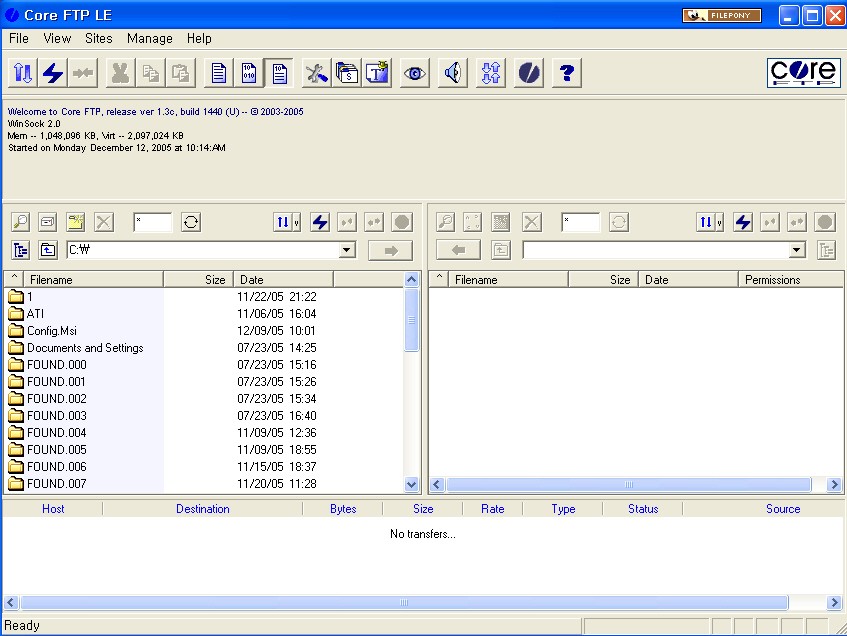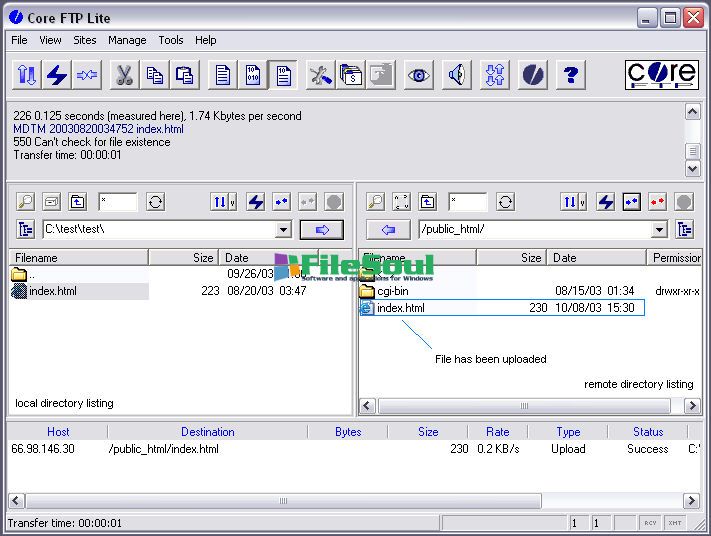

- Core ftp le profiles pro#
- Core ftp le profiles password#
- Core ftp le profiles download#
- Core ftp le profiles windows#
dira - Dump directory information into a file forcing ascii format. dir - Dump directory information into a file.

show– Show the transfer window when not in silent mode. Use:-hide– Hide the transfer window when not in silent mode.

ie: coreftp.exe -u c:\myfile -p /path/ -FN newfilename Use:-FN newfilename– use this to transfer a file to a different filename, used in conjunction with the -p parameter. Common used alone with site profile or FTP url. purge filespec days– Purge files of x days old. Command used alone (no transfers) with site profile or FTP url. Use:-delsrc– Delete the source file (upload or download) after successful transfer.
Core ftp le profiles pro#
In the Pro version, there is no splash screen. Use:-s - Will transfer file with no GUI except for a transfer dialog and overwrite prompts. Override Ascii or Binary mode for transfers:īy default, files are always transfered in binary mode unless specifed in the ascii extensions.
Core ftp le profiles password#
Ie: coreftp.exe -UNZIPONLY password c:\path\source.zip c:\desination\ Ie: coreftp.exe -ZIPONLY password c:\path\zippedfiles.zip c:\source\*.dat Local compressing(zip) and decompressing(unzip) of files (Pro only): Without this parameter the file will be named IBM.zip.
Core ftp le profiles download#
Ie: c:\(coreftp path)\corecmd.exe -s -oldest -site mysite -d /remote_path/*.txt -p c:\localdir\ To download the oldest file in a directory.ĭrive:\(coreftp path)\coreftp.exe -O -ZIP -AUTONAME -u c:\IBM -site siteprofile -p /public_html/uploadpath/ oldest - Transfer the newest file in a directory. newest - Transfer the newest file in a directory. OL– Overwrite destination file if source file size is less (smaller). OG– Overwrite destination file if source file size is greater. ON– Overwrite files that are newer than existing files. OA– Overwrite *all* if transfering a folder or directory of files. Upload: drive:\(coreftp path)\coreftp.exe -site mysite -u c:\myfile.dat -p /public_htm/mydirectory/ If you need to use special settings like SSL or SSH, create a site profile in the Site Manager and then use the following command line parameter.ĭownload: drive:\(coreftp path)\coreftp.exe -site mysite -d /directory/yourfile.dat -p c:\download\
Core ftp le profiles windows#
winssl– Use Windows security layer (OpenSSL by default)ĭrive:\(coreftp path\coreftp.exe -t templatenameĪdd -refresh to reload template file sizes. To block transfers during processing, use the ‘corecmd.exe’ utility with the normal command line parameters. To use a different desination directory, use the -p /directory/: (example with site profile).ĭrive:\(coreftp path)\coreftp.exe -site mysite -u c:\path\yourfile\file.dat -p /remotedir/īy default Core FTP command line works asynchronously. Make sure the URL has all appropriate userid/password/permissions for the remote FTP server. To rename the destination filename, use -FN ĭrive:\(coreftp path)\coreftp.exe -u c:\path\yourfileorpath\filename ĭrive:\(coreftp path)\coreftp.exe -u c:\path\yourfileorpath\*.jpg will upload the file or path specified into the directory specified by the URL. Wildcard support was added as of build 1250. To use a different destination directory, include: -p drive:\directoryĭrive:\(coreftp path)\coreftp.exe -d -p drive:\path\ If you don’t want the GUI to pop up, add the -s (silent) option to your command line parameters. This will download the file into the default download directory specified in options, or to the last local directory that was used while in the program. Command Lineĭownload a file via a FTP URL (see FTP URL’s for more information). CoreFTP has a summary of command line options in their Docs section. Please read the official documentation supplied with the binaries downloadable from the CoreFTP website for the most accurate information. Snapshot from their official documentation at 25th of July 2012.


 0 kommentar(er)
0 kommentar(er)
